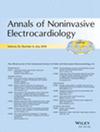室性心动过速可能源于他-浦肯野系统,可能是乌头碱中毒所致。
IF 1.1
4区 医学
Q4 CARDIAC & CARDIOVASCULAR SYSTEMS
引用次数: 0
摘要
准确诊断最早心室起源可能位于His-Purkinje系统的宽QRS复杂性心动过速(WCT),并探讨其病因,有助于进一步诊断和治疗。本文通过具体病例发现,乌头碱中毒是可能的病因之一。本文章由计算机程序翻译,如有差异,请以英文原文为准。

Ventricular Tachycardia Possibly Originated From the His-Purkinje System May Result From Aconitine Poisoning
Accurate diagnosis of wide QRS complex tachycardia (WCT) with the earliest ventricular origin potentially located in the His-Purkinje system, and exploration of its etiology are helpful for further diagnosis and treatment. This article finds through specific cases that one of the possible etiologies is aconitine poisoning.
求助全文
通过发布文献求助,成功后即可免费获取论文全文。
去求助
来源期刊
CiteScore
3.40
自引率
0.00%
发文量
88
审稿时长
6-12 weeks
期刊介绍:
The ANNALS OF NONINVASIVE ELECTROCARDIOLOGY (A.N.E) is an online only journal that incorporates ongoing advances in the clinical application and technology of traditional and new ECG-based techniques in the diagnosis and treatment of cardiac patients.
ANE is the first journal in an evolving subspecialty that incorporates ongoing advances in the clinical application and technology of traditional and new ECG-based techniques in the diagnosis and treatment of cardiac patients. The publication includes topics related to 12-lead, exercise and high-resolution electrocardiography, arrhythmias, ischemia, repolarization phenomena, heart rate variability, circadian rhythms, bioengineering technology, signal-averaged ECGs, T-wave alternans and automatic external defibrillation.
ANE publishes peer-reviewed articles of interest to clinicians and researchers in the field of noninvasive electrocardiology. Original research, clinical studies, state-of-the-art reviews, case reports, technical notes, and letters to the editors will be published to meet future demands in this field.

 求助内容:
求助内容: 应助结果提醒方式:
应助结果提醒方式:


